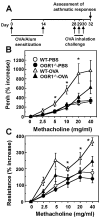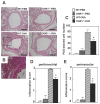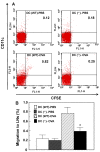Proton-sensing ovarian cancer G protein-coupled receptor 1 on dendritic cells is required for airway responses in a murine asthma model
- PMID: 24244587
- PMCID: PMC3823589
- DOI: 10.1371/journal.pone.0079985
Proton-sensing ovarian cancer G protein-coupled receptor 1 on dendritic cells is required for airway responses in a murine asthma model
Abstract
Ovarian cancer G protein-coupled receptor 1 (OGR1) stimulation by extracellular protons causes the activation of G proteins and subsequent cellular functions. However, the physiological and pathophysiological roles of OGR1 in airway responses remain largely unknown. In the present study, we show that OGR1-deficient mice are resistant to the cardinal features of asthma, including airway eosinophilia, airway hyperresponsiveness (AHR), and goblet cell metaplasia, in association with a remarkable inhibition of Th2 cytokine and IgE production, in an ovalbumin (OVA)-induced asthma model. Intratracheal transfer to wild-type mice of OVA-primed bone marrow-derived dendritic cells (DCs) from OGR1-deficient mice developed lower AHR and eosinophilia after OVA inhalation compared with the transfer of those from wild-type mice. Migration of OVA-pulsed DCs to peribronchial lymph nodes was also inhibited by OGR1 deficiency in the adoption experiments. The presence of functional OGR1 in DCs was confirmed by the expression of OGR1 mRNA and the OGR1-sensitive Ca(2+) response. OVA-induced expression of CCR7, a mature DC chemokine receptor, and migration response to CCR7 ligands in an in vitro Transwell assay were attenuated by OGR1 deficiency. We conclude that OGR1 on DCs is critical for migration to draining lymph nodes, which, in turn, stimulates Th2 phenotype change and subsequent induction of airway inflammation and AHR.
Conflict of interest statement
Figures








References
Publication types
MeSH terms
Substances
LinkOut - more resources
Full Text Sources
Other Literature Sources
Medical
Molecular Biology Databases
Miscellaneous

